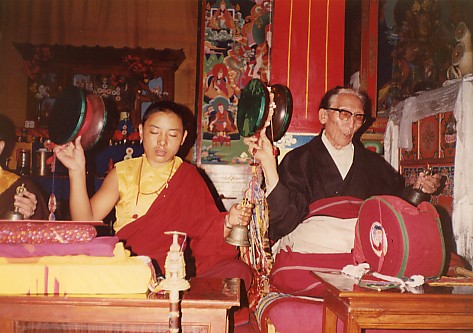| |
|
| |
 |
|
| |
|
|
| |
|
|
| |
Rinpoche's News - Page 2 |
|
| |
|
|
|
| |
| |
DAILY SCHEDULE
Lekshay Ling's daily schedule begins with the morning puja starting at 4:00 a.m. and ending at 6:30, breakfast time. At 7:00 a.m. there is time for study until the next puja at 8:00. 9:30 is time for tea and bread, and time for other pujas. Lunchtime is at noon, when the Triple Gem sutra (Könchok Jeten) and other food pujas are completed before eating. After this there is time for individual practise, turning the big prayer wheels, study, or rest, until it is time for tea and bread at 3:00 p.m. Daily Mahakala puja is then held, together with some other pujas. Supper is at 6:00 p.m., followed by Chöd and the evening fire puja. The day is concluded with five books of special wishing prayers. My uncle, the Chöd Master Namkha Dorje taught the special Chöd ritual and melody for Chöd practise that he learned from his uncle and great retreat lama, Lodro Chöpel, and from the great cave dweller, Pema Wangyal. They had both learned this from Drubtop Jamyang Tenphel Rinpoche, who in turn had received it from Jamgon Kongtrul Lodro Thaye. |
 Chöd Master Namka Dorje teaching Chöd and
Chöd Master Namka Dorje teaching Chöd and
practising with lamas and nuns |
|
|
|
| |
| |
On the eighth day of the lunar month Milarepa puja is held, and on the tenth day Tsedrup Sangwa Dupa (Amitayu long life puja). On the fifteenth and thirtieth days Kunrig Choga (Vairochana ritual) is held. This ritual is the best purification for this life and also the best for the liberation of dead people. On the ninth, nineteenth, and twenty-ninth days of the month a long Mahakala puja is held; and on the twenty-fifth day the Naro Kachöma puja. Lama Wangdü gave instructions on how to perform this ritual in the Tsalpa tradition.
In the first lunar month called Miracle Month, a Chakrasamvara Puja is held. Saga Dawa, the fourth lunar month, is the special month for Chenrezig practise, and also marks the triple anniversary of Buddha’s birth, enlightenment, and paranirvana. Two Nyungnays are held at this time. Nyungnay is a Thousand Arm Chenrezig practise, conducted over two days. On the first day one eats only lunch and practises all day, and the second day is a full day of practise where one observes silence and fasts, abstaining from all food or drink. This Nyungnay practise lineage was founded by the fully enlightened bhikkuni Gelongma Palmo over a thousand years ago, and her lineage later came to Tibet. The second Nyungnay month is the ninth, called Dig-da, when we also hold two Nyungnays. Recently, an additional set of Nyungnay is sponsored by Bongsar Tsodi on the anniversary of her mother's death. Namkha Dorje has very great faith towards this practise. In earlier times in Nangchen, Namkha Dorje’s family were the local rulers, and he organized the gathering of many people for Nyungnay practise. Together, they would complete several thousand Nyungnays a year. Even after coming to India he continued the tradition in Mainpat, so since moving to Nepal he continues by sponsoring Nyungnays at Lekshay Ling.
In the evening of the 25th day of the tenth lunar month, the anniversary of Je Tsongkhapa (Gaden Ngamchö), many butterlamps are offered and lit on the monastery roof while everyone repeats the Verse of Tsongkhapa.
The resident lamas and some nuns at Lekshay Ling have finished the three year retreat. All nuns have either finished or are still completing Kachöma Zhenyin or Kachöma Drubum retreat. |
|
|
|
| |
| |
 |
|
The main statue of the Lekshay Ling shrine is a one and a half storey high Shakyamuni Buddha. There are one storey high statues of One Thousand Arm Chenrezig and Guru Rinpoche, and human-sized Kachoma and Green Tara. The Bhutanese sculptor who made the statue of Green Tara said that the face formed unusually easily as he worked. This is called Rang Jön, "self-arising". He felt that this was very auspicious, and a great blessing. There is also a statue of Gelongma Palmo, the founder of Nyungnay practise, and on either side of Shakyamuni are statues of his two attendants, Shariputra and Mangalaputra. There are also three foot tall statues of Singhamukha and Guru Drakpo. Lama Pekar and Lama Tsenjur were both in charge of the placing of wonderful Zungshuk - mantras, chakras and other holy relics - inside all of these statues. |
|
Tara sculptor found the face formed
unusually easily: "self-arising"
|
|
|
| |
|
|
|